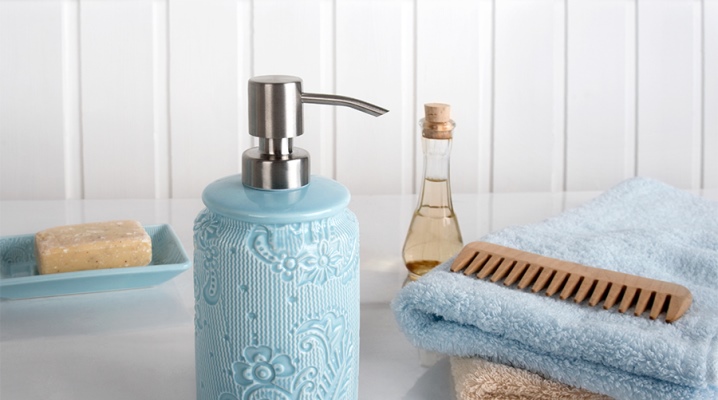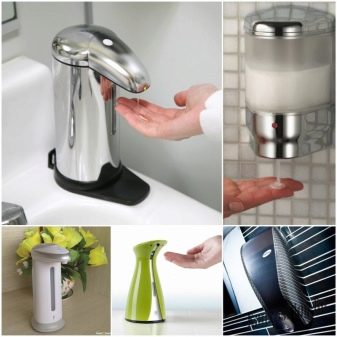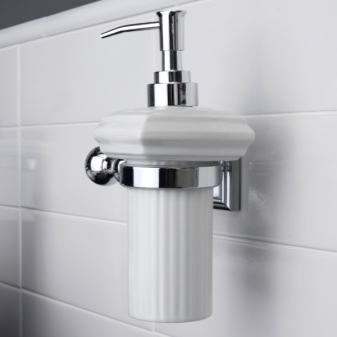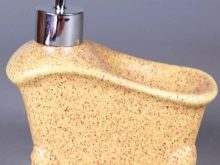The subtleties of choosing a dispenser for liquid soap

Nowadays, experienced housewives are increasingly choosing liquid soap dispensers instead of conventional soap dishes. And this is not surprising. The convenience and hygiene of this device will be discussed in this article.


Peculiarities
You may have noticed that water is constantly retained in a regular soap dish after using soap, and stagnant moisture is an excellent medium for the appearance and reproduction of fungal bacteria. Therefore, it is imperative to keep the soap dish clean and dry, but there is not always time to focus on this. Therefore, convenient dispensers have replaced conventional soap dishes. They are extremely easy to use and keep clean, and they have a very beautiful and stylish appearance. There are a huge variety of different dispenser models on the market, so choosing a device according to your criteria is not difficult.



Unlike regular bar soaps, liquid soaps in dispensers are hygienic. It has a rich aroma and is more economical to use. Therefore, more and more often you can find them in public places and places with a large crowd of people. And rightly so, hardly anyone would want to wash their hands with an incomprehensible bar of soap, which hundreds of people had washed their hands with before, or maybe he still managed to lie somewhere. A fragrant, beautifully colored liquid soap in a dispenser is another matter.


Despite the fact that the purpose of such a device as a dispenser (dispenser) is simple and clear, manufacturers are trying to surprise their customers with all new types and models of equipment. So be sure to check the dispenser options before buying. The selection of them on the market is quite large, and they all have a broad classification in several areas.


Views
As mentioned above, there are many types of dispensers. The choice depends on your budget, as well as the functionality you need. To do this, you need to understand the advantages and differences of some models from others.


Briefly, the entire range of dispensers can be divided into:
- mechanical;
- elbow;
- sensory.



Mechanical liquid soap dispensers are the most popular household soap dispensers. They operate on the principle of pressing a button. In this case, the required amount of soap is dispensed. If it was not enough, you can repeat the process. It is a necessary accessory for a bathroom or kitchen, which has a nice price and a huge variety of different designs and options. You can easily find what is right for you.


Elbow dispensers are actuated by elbow pressure. These are highly hygienic devices, because they avoid manual contact with its elements. The dosage of the soap is also determined by pressing the dispenser lever with your elbow. Often, these types of dispensers can be found in medical institutions or in kitchens in the catering system, where it is extremely important to maintain absolute hygiene. The cost of such mechanisms is low, but most likely they will not be suitable for a home in their appearance. Too simple and unremarkable.


Touch dispensers can also be called automatic or non-contact. These are the most advanced models that allow you to completely avoid physical contact with the device, ensuring one hundred percent hygiene.In order to use soap, you just need to bring your hands to the dispenser, and it will automatically give you a dosed volume of liquid. Typically, these devices operate on type C or D batteries. These batteries have a fairly long life, so they will last for a large number of triggers. You don't have to change them often. Dispensers installed in public areas can be powered by mains or can be powered by batteries or electricity. In terms of cost, these are the most expensive devices; it is not always advisable to use them at home.



By the type of attachment, there are wall, tabletop and built-in dispensers. Wall mounted dispensers are convenient for use in public spaces or small home bathrooms to save space. They usually have a convenient button to press, a reliable pump and a sight glass that allows you to control the level of soap in the device. The floor-mounted double dispenser can be opened with a key.
Tabletop dispensers are popular for use in the kitchen or bathroom. They have a huge range of designs to suit the requirements of any interior. The built-in mechanism dispenses soap, thus saving its consumption. Such dispensers do not cause any inconvenience when leaving them, they are quite easy to unwind and wash inside and out if necessary. Such dispensers are made of moisture-resistant and wear-resistant materials, they can be of various shapes, colors and have an affordable price.


Embedded devices are distinguished by their stylish look. The mortise soap container is hidden under the countertop, thanks to which a free space is formed on top. You don't have to go under the sink to refill the tank. As a rule, you can add soap to the device from the top. The dispenser is easy to install and easy to use. The body and the delivery tube are made of high-strength plastic, which prevents corrosion from water and chemical detergents. The disadvantages of this device include its high cost.
For a room where food is prepared, it is advisable to choose a kitchen hinged or hanging appliance.


Materials (edit)
By choosing the right soap dispenser, you will not only protect yourself from nasty and harmful bacteria, but also transform your kitchen or bathroom interior. And in order for the selected dispenser to serve you faithfully for a long time, you should pay attention to the material from which its body is made, as well as to the pump mechanism.
The standard material from which dispensers are made is stainless steel, glass or plastic. Each of them has both pros and cons. Next, we will consider the characteristics of these materials.



The main advantage of plastic is its cheapness. Despite this, you can find plastic dispensers of quite high and decent quality. For the convenience of buyers, designers have developed a huge variety of different designs, shapes and colors of plastic dispensers. It is best to choose a dispenser from this material if a portable type of device is required.



Glass dispensers are best suited for wall mounting. This will prevent the device from overturning. Such models on the wall, filled with fragrant and pleasant in color liquid soap, look very stylish, neat and expensive. The disadvantage of this type of device is its high price.
The stainless steel product is a versatile, convenient, practical and beautiful device.that will easily fit into different styles of bathroom or kitchen decoration. It can be wall-mounted, shelf-mounted, or mounted on a sink. The dispenser made of steel is a reliable and safe device in operation.


When choosing a dispenser, be sure to pay attention to whether the chosen model suits the style of your bathroom or kitchen. To achieve the best effect, use not only the dispenser, but also try to choose a set of accessories from the same series. For example, a toothbrush dispenser and glass in the same style and color.
The above are the main materials from which the dispensers are made, but today on the market you can also find dispensers made of materials such as ceramics, stone, wood, bronze, brass and others.


Dosing mechanisms
A dispenser is a container that is filled with liquid and a mechanism by which the liquid is dispensed and dispensed to the consumer. In another way, this mechanism can be called a pump. Dispensers are also distinguished by the type of the dispensing mechanism and the form of liquid dispensing. There are three forms of fluid supply:


Jet
When pressed, the liquid is discharged in a stream. Typically, this shape is predominantly suitable for liquid soap dispensers. The soap has a thick consistency, so the outlet should be quite large. Also, this type is suitable when using a gel-like antiseptic, because their consistencies are similar.

Foam
The dosing mechanism is equipped with a special foamer. Thanks to him, foam immediately forms from the soap.

Spray
This type of dispensing mechanism is used in antiseptic dispensers. When pressed, the liquid is sprayed. The outlet of the mechanism is very small, thanks to which the antiseptic is sprayed onto the hands evenly.

The volume of a dose of liquid per actuation varies depending on the shape of the mechanism. There is no generally accepted norm, so each manufacturer sets his own.
The approximate average data are presented below.
- liquid soap is dispensed in approximately 1 ml per 1 press;
- soap-foam - about 0.6 ml at a time;
- skin antiseptic - 1.5 ml for 1 actuation.



Some manufacturers reserve the right for the user to change the volume of fluid dispensed per actuation. There are few such devices, but sometimes they are necessary and in demand.
The pump, according to its design, can be either built into the dispenser body or removable. When choosing a dispenser, remember that the removable mechanism has clear advantages. First, the detachable pump can be easily removed and rinsed as needed. Secondly, in the event of a breakdown, it can also be easily removed and replaced with a new one. And in the case of a built-in mechanism, you will have to dismantle and change the dispenser completely.



Before choosing the correct dispenser, decide on the type of liquid you will be using. Because if you use the dispensing mechanism for other purposes, negative consequences can soon appear that will lead to equipment damage.


Design
From an aesthetic point of view, the use of dispensers looks very impressive and stylish. Thanks to their design, they can bring a bright accent to the interior and decorate any room. You can come across a huge selection of stylish, unusual and colorful dispensers for every taste. For example, the square version is quite popular.
Many devices are equipped with a special window that allows you to control the level of liquid soap and replenish it in a timely manner. The existing touch panel allows you to wash your hands with soap and water without touching the accessory itself.


An original and practical design for the dispenser with a cleaning sponge. It has a fixed base for a washcloth or sponge. This version is very convenient to use, it can be installed directly into the shower or bath.


Among the most popular colors of these products:
- Brown;
- Red;
- lilac;
- green;
- blue;
- gold;
- transparent;
- Orange.



Manufacturers
Today it is quite easy to buy a dispenser for liquid soap that is right for you both in price and in functionality.There is a huge selection of manufacturers from China, Germany, Italy, Spain, Russia, which offer a wide selection for every taste. Some of the well-known manufacturers are Binele, Bxg, Connex, G-teq, Ksitex, Rossinka and others.
Tork Turkish soap dispensers easy to operate and provide a high level of cleanliness. They have easy and quick cartridge replacement. Dispensers have a soft-touch button. This is confirmed by a certificate from the Swedish Association of Rheumatology.



Dispensers for liquid soap from the Spanish brand Losdi made of impact-resistant ABS plastic. They are equipped with a reliable push-button mechanism. Some models are additionally provided with a lock.

Placement and Operation Tips
You should choose which type of dispenser is right for you - wall-mounted, table-top or built-in. According to the filling method, there are filler and cartridge dispensers. By the names, the principle of operation of such dispensers is clear. Cartridge devices have a drawback - it is an unreliable fastening of a removable container and the likelihood of its theft. The volume can be different and reach 1.2 liters.
In crowded places, it is recommended to use dispensers made of high-quality and impact-resistant plastic or stainless steel. It is not worth saving when choosing this device. The detergent supply mechanism must be of high quality and reliable. If there is a glass for controlling the level of liquid soap, then it should also be impact-resistant, but it could be easily opened if necessary. Refilling the dispenser should only be possible with a special key that allows access to the device from the inside.


If the dispenser is mechanical, then by pressing the button you will receive approximately 0.1 to 0.4 ml of the product. In the case of automatic dispensers, the dose of soap dispensed will be accurate and more economical. Sensor dispensers are characterized by greater hygiene, as they exclude any contact with the surface of the device. It is wise to use them in restaurants, hotels, hospitals and other places of large gatherings. This variant of the device will also emphasize the solidity and status of the institution.
Dispensers with a large volume are most convenient for use in places where there is a large number of people. These are places such as airports, train stations, shopping and entertainment centers, etc.


After examining all the features, pros and cons, types of liquid soap dispensers, you can easily find what you need.
An overview of the automatic liquid soap dispenser is waiting for you in the next video.













The comment was sent successfully.